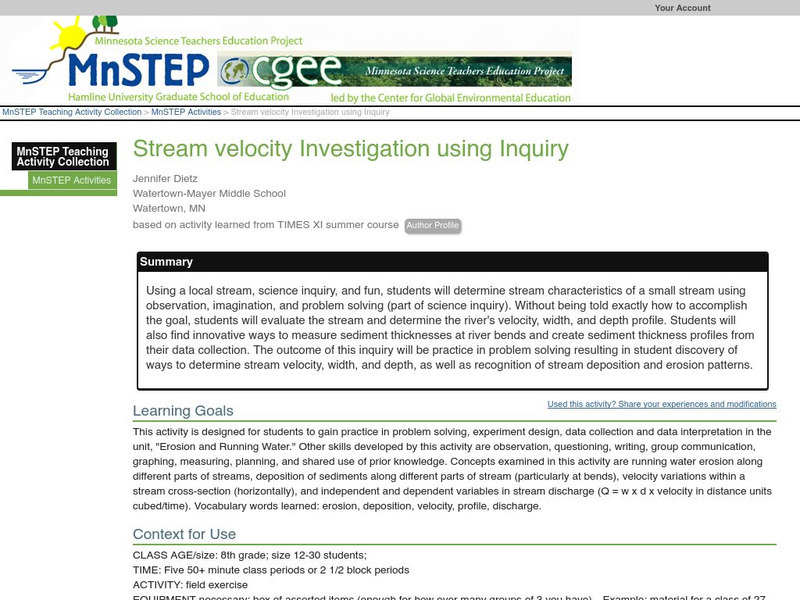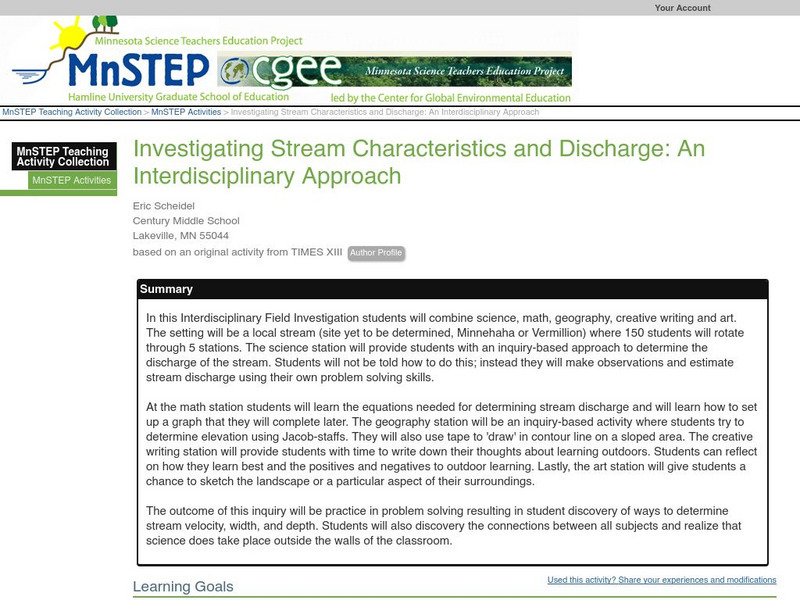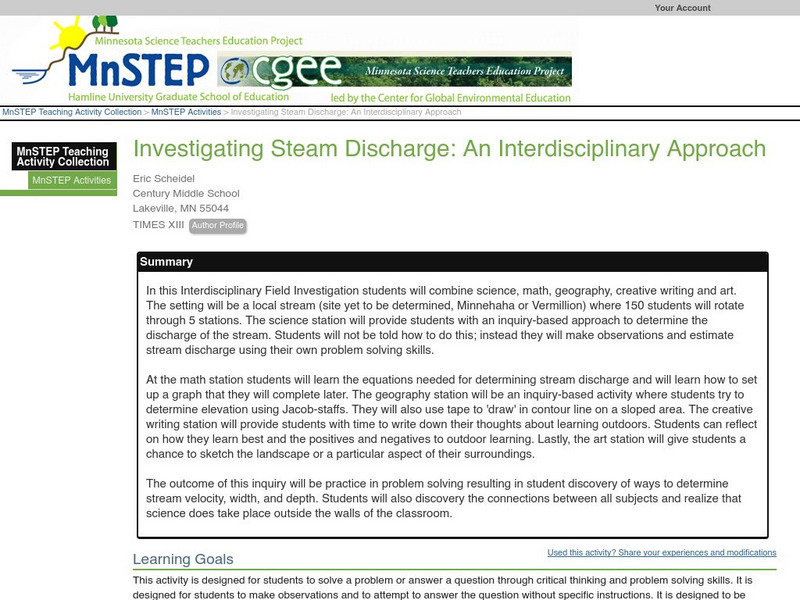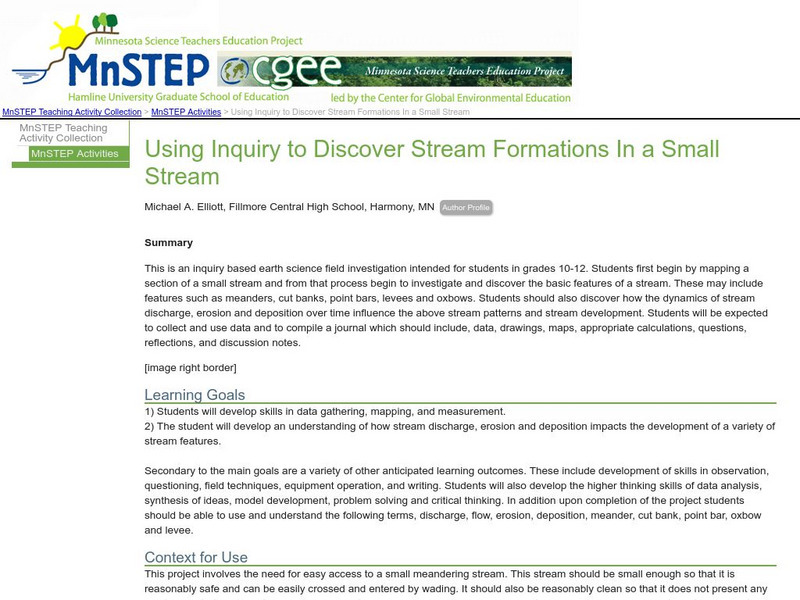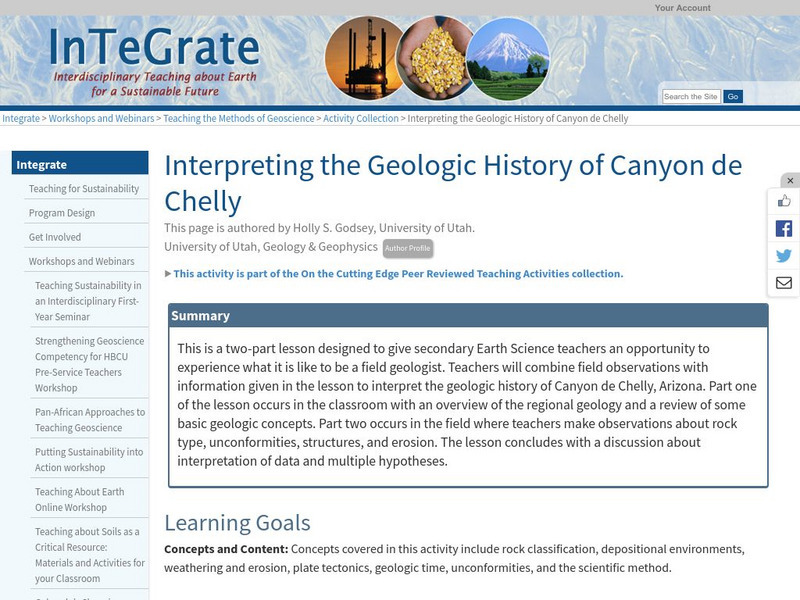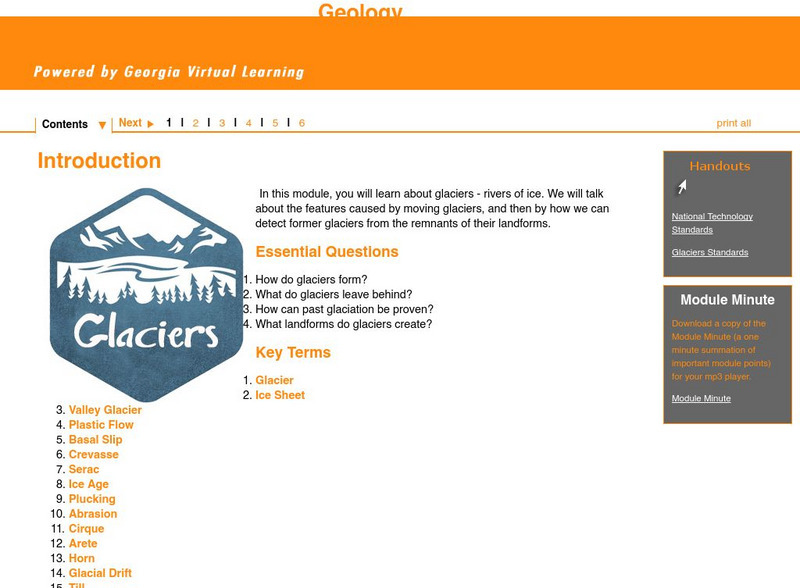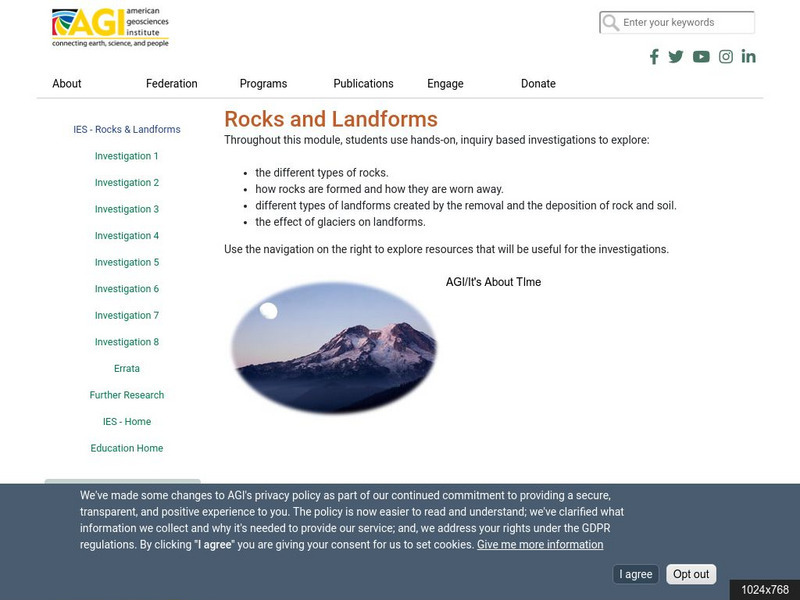National Snow and Ice Data Center
National Snow and Ice Data Center: All About Glaciers
Extensive information about glaciers. Tells about the life of a glacier, how they form, how they impact the surrounding areas, and what happens when glaciers stop growing. Includes a photo gallery, and links to scientific research on...
ClassFlow
Class Flow: Rivers 2
[Free Registration/Login Required] In this lesson students evaluate the water cycle and how rivers erode, transport, and deposit materials to produce physical features. Many slides and aerial photos of flooding and riverbanks are...
Other
Virtual Courseware Project: Geology Labs on Line: Virtual River
Learn about river processes like discharge, flooding, flood frequency, erosion, and deposition in this interactive tutorial. Tutorial includes interactive exercises and assessments.
Curated OER
National Park Service: Varying Valleys
The NPS offers a good description of the three main types of valleys, lesson objectives, and modeling activities.
Curated OER
National Park Service: Geology of Devil's Tower
Welcome to Devil's Tower National Park in Wyoming! This highly interactive website reveals the geological processes behind the formation of this unique natural structure.
PBS
Pbs Learning Media: Coastal Geological Materials
This interactive resource adapted from the National Park Service describes the different kinds of sediments that make up coastlines, with a focus on the variety in color, size, and sorting.
Science Education Resource Center at Carleton College
Serc: Mn Step: Stream Velocity Investigation Using Inquiry
An outdoor activity where students visit a local stream for a scientific inquiry. They make observations about the stream, and take measurements of the stream's velocity, depth, and width. They will also develop a sediment thickness...
Science Education Resource Center at Carleton College
Serc: Go Inquire System
Students us the GO Inquire online tool to develop knowledge and skills in the concepts of erosion, transportation, and deposition.
Science Education Resource Center at Carleton College
Serc: Investigating Stream Char and Discharge: Interdisciplinary Approach
In this Interdisciplinary Field Investigation students will combine science, math, geography, creative writing and art. The setting will be a local stream (site yet to be determined, Minnehaha or Vermillion) where 150 students will...
Science Education Resource Center at Carleton College
Serc: Investigating Steam Discharge: An Interdisciplinary Approach
In this Interdisciplinary Field Investigation students will combine science, math, geography, creative writing and art. The setting will be a local stream (site yet to be determined, Minnehaha or Vermillion) where 150 students will...
Science Education Resource Center at Carleton College
Serc: Using Inquiry to Discover Stream Formations in a Small Stream
Students map a section of a small stream, and from that process begin to investigate and discover the basic features of a stream and its development.
Math Science Nucleus
Math Science Nucleus: Maps as Tools
A series of lessons in which students learn about landforms. Includes interpreting landforms, creating landforms, and information on Angel Island.
National Association of Geoscience Teachers
Nagt: Variable Rivers
In this lesson young scholars will be introduced to rivers and river processes. They will test an isolated variable in rivers and they will test either the amount of water, velocity of water, or steepness of the river bed to determine...
Science Education Resource Center at Carleton College
Serc: Interpreting the Geologic History of Canyon De Chelly
Earth Science teachers will combine field observations with the information given in the classroom to interpret the geologic history of Canyon de Chelly, Arizona.
Sophia Learning
Sophia: Geology: Sedimentary Rocks
Listen to this podcast which explains the various processes that form sedimentary rock. [0:32]
CK-12 Foundation
Ck 12: Earth Science for Middle School
This digital textbook covers core earth science concepts and includes interactive features, real-world examples, videos, and study guides.
Other
Moorland School: Earth Science Zone: The Rock Cycle
Did you know the rock cycle is a continuous cycle that takes hundreds of millions of years? This webpage explains how sedimentary, metamorphic, and igneous rocks are formed. It also gives examples of each type of rock. Also includes a...
ClassFlow
Class Flow: Coasts
[Free Registration/Login Required] A flipchart useful for checking students' understanding of the issues and the vocabulary associated with coastal zones.
The Franklin Institute
Franklin Institute: How Sedimentary Rock Is Formed
The Franklin Institute describes the way sedimentary rock is formed, with links to descriptions of several types of sedimentary rocks.
Georgia Department of Education
Ga Virtual Learning: Geology: Glaciers
In this interactive tutorial, you will learn about glaciers - rivers of ice. Learn about the features caused by moving glaciers.
Curated OER
National Park Service: Tour of Park Geology: Glaciers and Glacial Landforms
Investigate glaciers past and present through this website that explores glaciers found in the National Park Service.
American Geosciences Institute
American Geosciences Institute: Rocks and Landforms
Eight hands-on lessons module where students learn about rocks and landforms. These inquiry-based investigations explore the different types of rocks, how they are formed, the different types of landforms, and the effects of glaciers on...
Curated OER
Educational Technology Clearinghouse: Maps Etc: North China, 1971
" North China includes the densely populated and intensively cultivated North China Plain, the loess-covered uplands of Shansi, northern Shensi, and eastern Kansu, and the sparsely populated, semiarid steppes of Inner Mongolia....
Other popular searches
- River Erosion and Deposition
- Wind Erosion and Deposition
- Wave Erosion and Deposition
- Water Erosion and Deposition
- Weathering Erosion Deposition
- River Erosion Deposition
- Stream Erosion Deposition
- Deposition and Erosion








